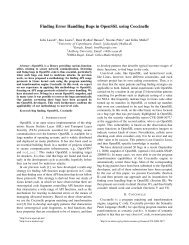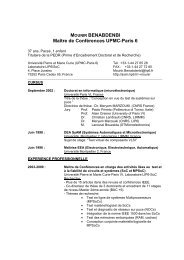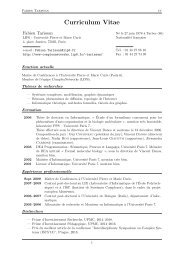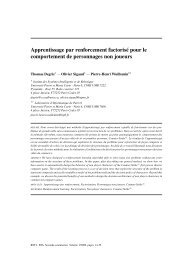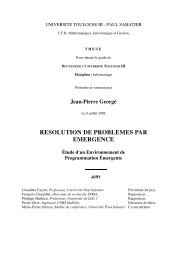Proceedings [PDF] - Measurement and Analysis of P2P Activity ...
Proceedings [PDF] - Measurement and Analysis of P2P Activity ...
Proceedings [PDF] - Measurement and Analysis of P2P Activity ...
Create successful ePaper yourself
Turn your PDF publications into a flip-book with our unique Google optimized e-Paper software.
International Conference Advances in the <strong>Analysis</strong> <strong>of</strong> Online Paedophile <strong>Activity</strong> Paris, France; 2-3 June, 2009<br />
However, police surveillance tactics deployed at network-level present real challenges to law<br />
enforcement in terms <strong>of</strong> detecting edge-based criminal activity <strong>and</strong> achieving effective online<br />
guardianship [6]. Three significant shortcomings can be observed. Firstly, too much data is<br />
produced to make pro-active analysis practical. Secondly, child sex <strong>of</strong>fenders <strong>of</strong>ten<br />
masquerade as children in order to make contact, making detection difficult. Thirdly, systems<br />
tend to be developed to monitor a predator stereotype (adult male) which does not reflect<br />
patterns <strong>of</strong> internet based sexual predation <strong>of</strong> children <strong>and</strong> young people [7]. For example,<br />
Finkelhor [8] found that young people themselves make aggressive sexual solicitations in<br />
almost half <strong>of</strong> all cases <strong>and</strong> that <strong>of</strong> those known to be adults (25%), the majority are aged<br />
between 18-25. In 27% <strong>of</strong> cases in this study (conducted in the US) the age <strong>of</strong> predators was<br />
unknown <strong>and</strong> could well include adults masquerading as young people. A key question yet to<br />
be addressed is how to distinguish both between adults predating as young people <strong>and</strong><br />
between ‘normal’ youth sexual behaviour on the internet <strong>and</strong> youth predation. Due to these<br />
challenges, policing organisations focus primarily upon reactive policing, wherein known<br />
culprits are identified <strong>and</strong> tracked <strong>and</strong> children are provided with mechanisms to report<br />
suspicious behaviour. Unfortunately, this approach is incapable <strong>of</strong> tackling many cases where<br />
children do not report incidents (in [8] only 3% reported) <strong>and</strong> where <strong>of</strong>fenders may be<br />
unknown to the authorities. Moreover, these policing tactics do little to advance a preventive<br />
approach to the problem <strong>of</strong> online grooming <strong>and</strong> predation within social networks by enabling<br />
effective guardianship <strong>and</strong> the potential for law enforcement intervention in pre-criminal<br />
situations, e.g., at the point <strong>of</strong> an early “friendly” online encounter between a prospective<br />
<strong>of</strong>fender <strong>and</strong> a child (see [6] for a discussion <strong>of</strong> the significance <strong>of</strong> <strong>of</strong>fender search, precriminal<br />
situations, opportunity <strong>and</strong> other contextual factors in the prevention <strong>of</strong> Internet<br />
crimes against children).<br />
In terms <strong>of</strong> language monitoring capabilities the existing chat policing s<strong>of</strong>tware tools rely on<br />
human monitoring <strong>of</strong> logs or simple-minded keyword or phrase detection based on userdefined<br />
lists. Such techniques do not scale. Nor do they enable identification <strong>of</strong> adults<br />
masquerading as children or support pro-active policing. Techniques do exist which make use<br />
<strong>of</strong> statistical methods from computational linguistics <strong>and</strong> corpus-based natural language<br />
processing to explore differences in language vocabulary <strong>and</strong> style related to age <strong>of</strong> the<br />
speaker or writer. The existing methodologies, such as key word pr<strong>of</strong>iling [9], draw on large<br />
bodies <strong>of</strong> naturally occurring language data known as corpora (sing. corpus). These<br />
techniques already have high accuracy <strong>and</strong> are robust across a number <strong>of</strong> domains (topics)<br />
<strong>and</strong> registers (spoken <strong>and</strong> written language) but have not been applied until now to uncover<br />
deliberate deception. The second relevant set <strong>of</strong> techniques is that <strong>of</strong> authorship attribution.<br />
The current methods [10] would allow a narrowing in focus from the text to the individual<br />
writer in order to generate a stylistic fingerprint for authors.<br />
For policing file sharing systems two significant tools exist, Peer Precision 5 <strong>and</strong> Log<strong>P2P</strong> 6 .<br />
Both systems also use a network-level tracing methodology in conjunction with a ‘honey-pot’<br />
approach, wherein the policing peer <strong>of</strong>fers an illegal file to the network <strong>and</strong> when an <strong>of</strong>fender<br />
attempts to download this file, client-side s<strong>of</strong>tware captures the <strong>of</strong>fender’s IP address at the<br />
packet-level. This approach suffers from two significant shortcomings. Firstly, it is unable to<br />
differentiate between those who download <strong>and</strong> share a single file, <strong>and</strong> those who are the<br />
‘core’ distributors <strong>of</strong> child abuse media (e.g. distributing many thous<strong>and</strong>s <strong>of</strong> files, producing<br />
<strong>and</strong> distributing child abuse imagery or uploading newly-produced child abuse material for<br />
the first time). This is a significant problem for frequently backlogged child protection<br />
agencies with limited resources. Secondly, as these systems work at the network-level, they<br />
can potentially be thwarted by encryption at the application-level. This is <strong>of</strong> particular<br />
significance as recent research has shown that users are migrating to more anonymous <strong>and</strong><br />
secure file sharing systems [3]. Finally, <strong>and</strong> perhaps most critically, the honey-pot approach<br />
5 www.icactraining.org/<strong>P2P</strong>.htm<br />
6 aidounix.com/Log<strong>P2P</strong><br />
35


![Proceedings [PDF] - Measurement and Analysis of P2P Activity ...](https://img.yumpu.com/32964521/35/500x640/proceedings-pdf-measurement-and-analysis-of-p2p-activity-.jpg)

